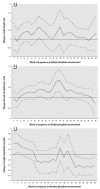Association of in utero organophosphate pesticide exposure and fetal growth and length of gestation in an agricultural population
- PMID: 15238287
- PMCID: PMC1247387
- DOI: 10.1289/ehp.6789
Association of in utero organophosphate pesticide exposure and fetal growth and length of gestation in an agricultural population
Abstract
Although pesticide use is widespread, little is known about potential adverse health effects of in utero exposure. We investigated the effects of organophosphate pesticide exposure during pregnancy on fetal growth and gestational duration in a cohort of low-income, Latina women living in an agricultural community in the Salinas Valley, California. We measured nonspecific metabolites of organophosphate pesticides (dimethyl and diethyl phosphates) and metabolites specific to malathion (malathion dicarboxylic acid), chlorpyrifos [O,O-diethyl O-(3,5,6-trichloro-2-pyridinyl) phosphoro-thioate], and parathion (4-nitrophenol) in maternal urine collected twice during pregnancy. We also measured levels of cholinesterase in whole blood and butyryl cholinesterase in plasma in maternal and umbilical cord blood. We failed to demonstrate an adverse relationship between fetal growth and any measure of in utero organophosphate pesticide exposure. In fact, we found increases in body length and head circumference associated with some exposure measures. However, we did find decreases in gestational duration associated with two measures of in utero pesticide exposure: urinary dimethyl phosphate metabolites [beta(adjusted) = -0.41 weeks per log10 unit increase; 95% confidence interval (CI), -0.75 -- -0.02; p = 0.02], which reflect exposure to dimethyl organophosphate compounds such as malathion, and umbilical cord cholinesterase (beta(adjusted) = 0.34 weeks per unit increase; 95% CI, 0.13-0.55; p = 0.001). Shortened gestational duration was most clearly related to increasing exposure levels in the latter part of pregnancy. These associations with gestational age may be biologically plausible given that organophosphate pesticides depress cholinesterase and acetylcholine stimulates contraction of the uterus. However, despite these observed associations, the rate of preterm delivery in this population (6.4%) was lower than in a U.S. reference population.
Figures

References
-
- Abu-Qare AW, Abdel-Rahman AA, Ahmad H, Kishk AM, Abou-Donia MB. Absorption, distribution, metabolism and excretion of daily oral doses of [14C]methyl parathion in hens. Toxicol Lett. 2001;125:1–10. - PubMed
-
- Abu-Qare AW, Abou-Donia MB. Urinary excretion of metabolites following a single dermal dose of [14C]methyl parathion in pregnant rats. Toxicology. 2000;150:119–127. - PubMed
-
- Barr JR, Driskell WJ, Hill RH, Needham LL, Head SL, et al. Strategies for biological monitoring of exposure for contemporary-use pesticides. Toxicol Ind Health. 1999;15:168–179. - PubMed

